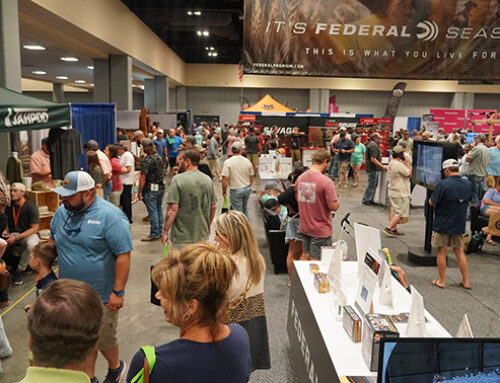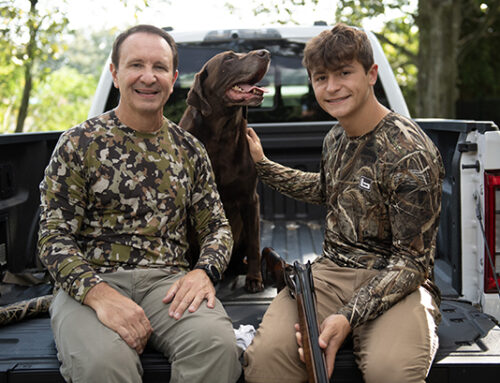A Thrill to Judge

Federal Duck Stamp contest winner. Richard Clifton. Acrylic painting of a lesser scaup. © USFWS.
Delta Waterfowl’s editor represents hunters at the Federal Duck Stamp Art Competition.
A hint of disbelief lingered — despite having already logged more than 600 miles and 10 hours of driving — as my rental car zipped east at 70 mph through Pennsylvania’s Allegheny Mountains.
My smile broadened as I reminded myself that yes, I really had been selected to judge the 2020 Federal Duck Stamp Art Competition.

Second Place. James Hautman. Acrylic painting of a flock of lesser scaup. © USFWS.
More importantly, now I was actually going to do it — COVID-19 and any other obstacles be damned.
I was thrilled in July when I received the offer from Suzanne Fellows, chief of the Federal Duck Stamp Office for the U.S. Fish and Wildlife Service. But there was a catch: Her letter detailed that while the 2020 judging originally was slated to occur at Drake University in Des Moines, Iowa, the ongoing pandemic necessitated a change of venue to the USFWS offices in Falls Church, Virginia.
For me, flying was not an option. So instead of a six-hour road trip to Iowa from my Wisconsin home, a check of Google maps revealed my trek to the Washington D.C. area would take more than 15 hours and cover 910 miles.
Painfully, I considered declining. But I just couldn’t.
Judging the Federal Duck Stamp Competition has been a lifelong goal. To be considered as a judge, you must have extensive knowledge about waterfowl, a demonstrated history of working with wildlife art/photography and prior experience judging stamp competitions. My 25-year career in outdoor media, much of it working for waterfowl publications, certainly checks two of those criteria. And in 2015, I judged the Wisconsin state pheasant, turkey and waterfowl stamp art competitions. I felt like my resume was strong.
Still, there was no guarantee I’d get another chance. The list of prospective judges contains more than 125 people, and the Secretary of the Interior must approve the selection of candidates. Administrations change, and opportunities can be fleeting. Only five people are chosen each year. In 2020, I was determined to be one of them.
So, armed with a handful of face coverings, a fresh bottle of hand sanitizer and an enthusiastic eye for the nation’s top waterfowl paintings, I buckled in for a long drive east.

Judgment Day 1
Along with four other judges, I arrived at the USFWS offices on Sept. 25 to begin the important task of choosing the painting that would become the 2021-2022 Federal Migratory Bird and Habitat Stamp, the 88th stamp in the history of the program that began in 1934.
As I’ve written about before, Delta Waterfowl has historical ties to the creation of the Federal Duck Stamp Program. Frederic Walcott, a U.S. senator from Connecticut, co-sponsored the bill that created the stamp. Walcott, along with artist Jay Norwood “Ding” Darling, initiated what has become one of the most successful conservation programs in the world, having raised more than $1 billion to conserve more than 6 million acres of habitat for waterfowl and other wildlife. In 1935, Walcott and Darling founded the American Wildlife Institute, an organization that joined forces with James Ford Bell in 1938 to help launch the Delta Waterfowl Research Station in Manitoba.
I proudly walked into the artwork display area to be greeted by 138 entries, each a 7-by-10-inch painting with 1-inch white matting. Every year, only five chosen species are eligible. For 2020, they were lesser scaup, cinnamon teal, gadwall, brant and red-breasted merganser. No writing is allowed on the front of any entry — no artist signatures, words on signs, numbers on bands — nothing. Each entry must be anonymous.
Entries are numbered in the order they were received by the Duck Stamp Contest Office. After a brief look at walls of paintings, judges assembled for a meeting to go over the rules with contest coordinator Larry Mellinger. We were not allowed to comment about entries, discuss our opinions or influence other judges. However, we could ask questions to USFWS biologist Kathy Fleming about the anatomical accuracy of birds or habitat depicted in the artwork.
“You have a difficult job in front of you,” Fellows said, as she turned us loose to examine each painting closely before the formal judging started.
She was right. During my first walk-through, I spotted a couple dozen entries that would make excellent duck stamps. Picking favorites was going to be tough. Thankfully, I didn’t have to choose which I liked the most just yet.
The contest had three rounds. For Round 1, we simply voted “in” or “out.” If an entry received three or more “in” votes from the panel, it advanced to Round 2.
Soon, we took our positions in our voting booths for the live-streamed judging. Entries were paraded past each judge, and we held our cards high for the camera. At the end of Round 1, we had narrowed the field to 42 entries.
But hold on. Each judge could select up to five of the eliminated paintings to advance. Through these “judge’s picks,” we collectively added 10 entries back into the mix.

Picking a Winner
The next morning, judging got serious. We arrived at the USFWS office knowing we were going to select the next duck stamp, however long it took.
For Round 2, judges were given cards numbered 1 through 5. The five highest point totals, including ties, would advance to the final round. Tension loomed in the room as we raised our scores for each entry. I decided not to demean any paintings with a 1, as all of them were nice artwork. However, I did rate my favorites with 4’s and 5’s. By then, I had settled on my Top 5, but not necessarily in a particular order. I suspect the other judges had done similar mental gymnastics to arrive at a scoring method.
Rather shockingly, we had eliminated all but seven entries after Round 2.
I was nervously excited as I viewed the final seven paintings on the board. Most of the finalists were lesser scaup. In fact, only a single painting of brant and one of a gadwall hung amongst five lesser scaup entries. And four of my Top 5 choices remained in the running.
For the final round, we only had cards numbered 3, 4, and 5 to rate the paintings. The pressure was on. Now I needed to decide which entry would make the best duck stamp. My favorite entries were a pair of hunting scenes that featured lesser scaup, and the brant hunting scene. I decided to give those two scaup entries 5’s, and the brant a 4. The rest got a 3 from me. It’s weird to score an amazing professional painting a 3 — they all deserved a 5. But hey, our job was to select a winner, not deadlock in a seven-way tie for first place.

Third Place. Joseph Hautman. Acrylic painting of a flock of lesser scaup. © USFWS.
Judging was swift, and almost surreal during the final round. We were about to make a single painting famous. The waterfowl world was watching.
After the scores were tallied, Mellinger announced that we had a clear winner, as well as a second and third place. There were no ties to be broken. Our work was done.
The painting of a single drake lesser scaup by Richard Clifton of Milford, Delaware, had won. My favorites, the scaup hunting scenes by James Hautman and Joseph Hautman, took second and third place.
After snapping a few photos with the winning entries, I headed back to Wisconsin, honored to have represented Delta Waterfowl, conservation and U.S. waterfowl hunters.
I can’t wait to sign and carry the 2021-2022 duck stamp in my wallet next season.
-Paul Wait






Nice work Paul! You represented Delta well!
Paul- Thanks for sharing a great story of your perseverance to be part of this special judging opportunity. Fifteen years ago when Richard Clifton’s painting of a Ring-necked Duck got him his first Duck Stamp win, I was there in Delaware to meet him at a ceremony recognizing his achievement. As a die-hard duck hunter, Richard represents the waterfowling community well and is very deserving of this honor. Enjoy toting that signed stamp afield with you this Fall!
Any response to completely snubbing the paintings John Oliver commissioned? I was very disappointed all of the panel didn’t realize the potential of adding humor into the Duck Stamp tradition.